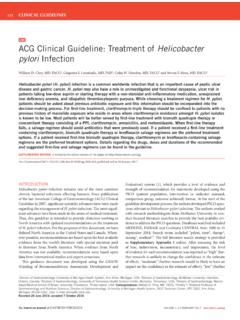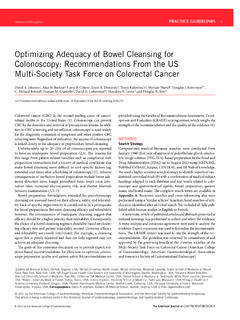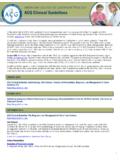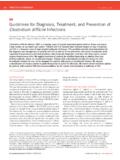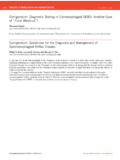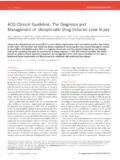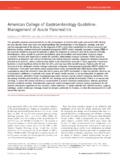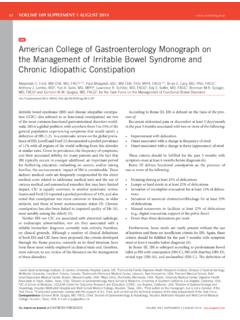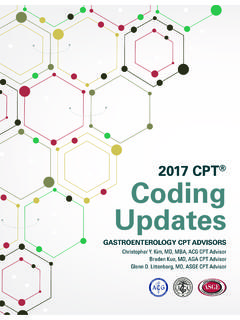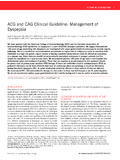Transcription of ACG Clinical Guideline: Diagnosis, Treatment, and ...
1 Nature publishing group602 The American Journal of GASTROENTEROLOGY VOLUME 111 | MAY 2016 guidelines INTRODUCTION Acute diarrheal infection is a leading cause of outpatient visits, hospitalizations, and lost quality of life occurring in both domes-tic settings and among those traveling abroad. Th e Centers for Disease Control and Prevention has estimated million cases occurring annually in the United States, at an estimated cost upwards of US$150 million to the health-care economy ( 1,2 ). Acute diarrhea can be defi ned as the passage of a greater number of stools of decreased form from the normal lasting <14 days. Some defi nitions require an individual to present with an abrupt onset 3 or more loose or liquid stools above baseline in a 24-h period to meet the criteria of acute diarrhea. Persistent diarrhea is typically defi ned as diarrhea lasting between 14 and 30 days, with chronic diarrhea generally considered as diarrheal symptoms lasting for greater than a month.
2 Acute diarrhea of infectious etio-logy is generally associated with other Clinical features suggest-ing enteric involvement including nausea, vomiting, abdominal pain and cramps, bloating, fl atulence, fever, passage of bloody stools, tenesmus, and fecal urgency. Acute diarrheal infection is also oft en referred to as gastroenteritis, and some acute gastro-intestinal infections may cause a vomiting predominant illness with little or no diarrhea. Th is guideline provides recommendations for the diagnosis , management, and prevention of acute gastrointestinal infec-tion focusing primarily on immune-competent adult individuals and does not consider Clostridium diffi cile -associated infections, which has recently been reviewed in a separate American College of Gastroenterology (ACG) Clinical Guideline ( 3 ). It replaces a previously published ACG Guideline on the same topic ( 4 ), and supplements previously published Infectious Disease Society of America (IDSA) ( 5 ), and World Gastroenterology Organiza-tion guidelines ( 6 ).
3 Th is guideline is structured into fi ve sections of Clinical focus to include epidemiology and population health, diagnosis , treatment of acute disease, evaluation of persisting symptoms, and prevention. To support the guideline development, a comprehensive literature search on acute diarrheal infection in adults was performed across multiple databases. A medical library information specialist searched the Ovid MEDLINE and EMBASE databases for relevant articles on 18 February 2015, using the fol-lowing main terms (with synonyms and closely related words): diarrhea AND acute disease, infectious diarrhea , dysentery, or acute gastroenteritis. Th e searches were limited to English language articles published in the past 10 years and excluded case reports, and child or animal studies. Details of the search methodologies are provided in the Appendix . Additional articles were obtained from review of references from retrieved articles, as well as articles that were known to authors.
4 Each section presents key recommendations followed by a summary of the evidence ( Figure 1 and Ta b l e 1 ). Th e GRADE system was used to grade the strength of our recommendations and the quality of the evidence ( 7 ). Th e strength of a recommenda-tion is graded as strong, when the evidence shows the benefi t of the intervention or treatment clearly outweighs any risk, and as conditional, when uncertainty exists about the risk benefi t ratio. Th e quality of the evidence is graded as follows: high, if further research is unlikely to change our confi dence in the estimate of the eff ect; moderate, if further research is likely to have an important impact and may change the estimate; low, if further research is ACG Clinical Guideline: diagnosis , treatment , and Prevention of Acute Diarrheal Infections in Adults Mark S. Riddle , MD, DrPH 1 , H e r b e r t L.
5 D u P o n t , M D 2 and Bradley A. Connor , MD 3 Acute diarrheal infections are a common health problem globally and among both individuals in the United States and traveling to developing world countries. Multiple modalities including antibiotic and non-antibiotic therapies have been used to address these common infections. Information on treatment , prevention, diagnostics, and the consequences of acute diarrhea infection has emerged and helps to inform Clinical management. In this ACG Clinical Guideline, the authors present an evidence-based approach to diagnosis , prevention, and treatment of acute diarrhea infection in both US-based and travel settings. Am J Gastroenterol 2016 ; 111:602 622; doi: ; published online 12 April 2016 1 Enteric Diseases Department, Naval Medical Research Center , Silver Spring , Maryland , USA ; 2 University of Texas Health Science Center at Houston , Houston , Texas , USA ; 3 Weill Medical College of Cornell University , New York , New York , USA.
6 Correspondence: Mark S. Riddle, MD, DrPH, Enteric Diseases Department, Naval Medical Research Center , 503 Robert Grant Avenue , Silver Spring , Maryland 20910 , USA . E-mail: Received 23 November 2015 ; accepted 16 March 2016 CMEC linical Guideline: Acute Diarrheal Infections 2016 by the American College of Gastroenterology The American Journal of GASTROENTEROLOGY 603very likely to change the estimate; very low, if an eff ect is very uncertain ( 8 ). EPIDEMIOLOGY AND PUBLIC HEALTH CONSIDERATIONS Recommendation 1 . Diagnostic evaluation using stool culture and culture-independent methods if available should be used in situa-tions where the individual patient is at high risk of spreading disease to others, and during known or suspected outbreaks. (Strong recommendation, low level of evidence) Summary of evidence . Surprisingly, there are few published studies that describe the overall incidence of acute diarrhea (including infectious and non-infectious causes) in the United States.
7 In 1998, the Foodborne Diseases Active Surveillance Network (FoodNet) conducted a random population-based telephone survey in which 12,755 persons (median age 40 years) were in-terviewed ( 9 ). Overall, 6% reported having experienced an acute diarrheal illness at some point during the 4 weeks preceding the interview (overall annualized rate, episodes per person-year; 15 24, episodes per person-year; 25 44, episodes per person-year; 45 64, episodes per person-year). A follow-up survey where 3,568 respondents (median age 51) were asked at random about illness in the previous 7 days or previous month found that recall bias had an important eff ect on estimates of acute gastrointestinal illness ( 10 ). Using a 7-day exposure win-dow, the estimated incidence of acute diarrhea was episodes per person-year, compared with episodes per person-year if asked about illness within the preceding month.
8 Other popula-tion-based studies from Canada and western European countries using varied methodologies estimate annual incidence between to episodes per person-year ( 11 ). Specifi cally focusing on infectious causes of acute diarrheal illness, in 2011 the Centers for Disease Control and Prevention Passage of 3 unformed stools in 24 h plus an enteric symptom (nausea, vomiting, abdominal pain/cramps, tenesmus, fecalurgency, moderate to severe flatulence)Oral fluid therapy: for all cases, hydrate through fluid and salt intakeFood: soups, broths, saltine crackers, broiled and baked foodsWatery diarrheaMild illness*Moderate-to-severe illness*No or low-grade fever( 100 F)Microbiologic assessment,then anti-microbial agentdirected to cause for all butSTEC infectionNon-travel-associatedTravel-ass ociatedHydrationonly, may useloperamide 4 mginitially tocontrolstoolingAntibiotictherapy(Table 4)No orlow-gradefever( 100 F)Fever( 101 F)<72 hdurationPersistent diarrhea (14 30 days) should be worked up by culture and/or culture-independent microbiologicassessment, then treatment with anti-microbial agent directed to cause 72 hdurationConsider 48 h ofloperamidetherapy*Illness severity:Severe totaldisability due todiarrhea; Moderate= able to functionbut with forcedchange in activitiesdue to illness.
9 Mild = no changein activitiesTr a v e l -associatedEmpirictreatment,Azithromycin 1 g in singledose OR 500 mgonce dailyfor 3 daysConsidermicrobiologicassessmentNon-t ravel-associatedSevere illness* with fever( 101 F) in a single case(not outbreak)Dysenteric diarrhea (passage of grossly bloody stools) Figure 1 . Approach to empiric therapy and diagnostic-directed management of the adult patient with acute diarrhea (suspect infectious etiology). Riddle et al. The American Journal of GASTROENTEROLOGY VOLUME 111 | MAY 2016 604 States caused million episodes of diarrheal illness, 55,961 hos-pitalizations, and 1,351 deaths. In addition, unspecifi ed agents resulted in 71,878 hospitalizations and 1,686 deaths, caused ~ million episodes of domestically acquired foodborne illnesses. In addition to domestically acquired infections, over 44 million US residents traveled abroad to non-Canadian and non-European updated the estimates of infectious gastroenteritis caused by a myriad of viruses, bacteria, and parasites ( 1,2 ).
10 Based on empirical modeling of active, passive, and outbreak surveillance data ~ million foodborne-related illnesses occur annually (one out of every six persons) in the United States. Furthermore, it was esti-mated each year that 31 major pathogens acquired in the United Table 1 . Summary and strength of recommendations Epidemiology and public health 1. Diagnostic evaluation using stool culture and culture-independent methods if available should be used in situations where the individual patient is at high risk of spreading disease to others, and during known or suspected outbreaks. (Strong recommendation, low level of evidence) diagnosis 2. Stool diagnostic studies may be used if available in cases of dysentery, moderate severe disease, and symptoms lasting >7 days to clarify the etiology of the patient s illness and enable specifi c directed therapy.(Strong recommendation, very low level of evidence) 3. Traditional methods of diagnosis (bacterial culture, microscopy with and without special stains and immunofl uorescence, and antigen testing) fail to reveal the etiology of the majority of cases of acute diarrheal infection.
